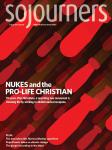I WAS SITTING IN the wrong end of a police wagon the first time I questioned nuclear weapons. Technically, it was a school bus, but it served the same purpose: hauling scores of protesters to the county holding center where we would await booking for our trespasses.
We had been protesting abortion. I was thinking about nuclear weapons because a couple of those in the bus were peace activists who had long rap sheets from years of anti-war protests. I, on the other hand, was a Republican-voting, independent Baptist church-attending, conservative-leaning, law-abiding (well, until now) kind of Christian. I was awed—and grateful—that these peaceniks would join the likes of me in common cause against another kind of violence.
My new friends adhered to the “seamless garment” philosophy, also called the consistent life ethic, one committed to the protection of all human life, whether from war, poverty, racism, capital punishment, euthanasia, or abortion. One of them gave me a button that read “Peace begins in the womb,” and I pinned it to the bottom of the black leather motorcycle jacket I used to wear in those days.
A few years and many more abortion protests later, I was starting a local chapter of Feminists for Life, attending an Episcopal church, heading up a small private school in the inner city, teaching at a Jesuit college, and reading the poetry of Father Daniel Berrigan, the famous Vietnam-era anti-war activist who was now being arrested for protesting abortion.
But I wasn’t thinking much more about nuclear bombs.
About 20 more years passed. I had given up on becoming Episcopalian and returned to the Baptist church and become a professor at a Baptist university. I was no longer wearing a black leather motorcycle jacket or even protest buttons. I’d exchanged my activism at the abortion clinics for a term on the board of directors of a local pro-life pregnancy center, and then exchanged that for simply writing about abortion now and then.
Haunted by the stories
But I was confronted with the issue of nuclear weapons again when I was asked to be part of a media delegation to last year’s international Conference on the Humanitarian Impact of Nuclear Weapons in Vienna, Austria. It wasn’t exactly a welcome invitation. The last thing I needed was another cause. Or another writing assignment. Yet, something drew me. Perhaps it was my younger, more radical self that beckoned. Perhaps it was the memory of those friends in the peace movement who had shaped and sharpened me so many years ago. Perhaps it was the lure of the Lipizzaner horses from Vienna that I have adored since I was a child. Whatever it was, I went.
The trip included two conferences, actually. The official, more formal event held at Hofburg Palace drew representatives from more than 160 countries, including the United States and the Vatican, to consider the global impact of nuclear weapons. This was preceded by a two-day conference hosted by the International Campaign to Abolish Nuclear Weapons (ICAN) in a baroque-era building whose crumbling plaster walls had been covered by whitewashed drywall. The institutional glare of the cheaply modernized building clashed against the tattered jeans, army fatigues, and canvas backpacks of the participants milling about who reminded me of the counterprotesters I’d faced years ago outside the abortion clinics. I found myself thinking about the police wagon and my old leather jacket.
Over four days, I viewed satellite images of hidden nuclear facilities around the world and learned which countries own nuclear weapons and which ones host them. I learned about the environmental devastation a nuclear winter could wreak. I learned that the number of nuclear weapons in the world today has been reduced from almost 70,000 to about 16,000. I learned that the United States signed the Nuclear Non-Proliferation Treaty in 1968, agreeing, along with numerous other countries, to work toward nuclear disarmament, a goal that continues to be official U.S. policy. Yet the United States spent an estimated $60 billion on these weapons in 2011 alone, I learned, and the Obama administration’s plan for modernizing the U.S. nuclear weapons complex will cost about $355 billion over the next 10 years, possibly $1 trillion in the next 30 years.
But more haunting than all these numbers were the stories. Victims of Hiroshima and Nagasaki told us what it was like to witness loved ones melting before their eyes following the blasts. We heard about women in the Marshall Islands, where the United States tested hydrogen bombs in the 1950s and 1960s, who gave birth to children with organs on the outside and no bones on the inside. They called them jellyfish babies. They made me think of the tiny, translucent little human fetuses pictured on the brochures we used to distribute outside the abortion clinics.
All human life begins the same way. Yet there are so very many ways to destroy it.
Perhaps it’s the seemingly infinite means of death that make it hard for the caring, conscientious person to know which to actively address—and which to surrender to helpless despair. It’s hardly surprising that the stance of the U.S. church, and most mere mortals, toward nuclear weapons—and toward abortion—ebbs and flows with political and cultural tides.
Within my own conservative Christian community, the present day flows toward greater national security. So I was surprised to learn that in 1983, in an essay titled “Noahic Covenant and Nuclear War,” Reformed theologian John Piper, while saying that war was sometimes necessary, warned that “the indiscriminate annihilation of thousands or millions of God’s image-bearers is such a blatant assault on God and his revealed will that Christians must not share in the act.”
And the year before—this was at the height of the Cold War, and the arms race seemed to be spiraling out of control—the Southern Baptist Convention (my own denomination) issued an anti-nuclear weapons resolution at its annual meeting, stating: “[W]e support a program of mutually verifiable disarmament, including nuclear disarmament; and we assure the United Nations Special Session on Disarmament of our prayers and hopes for progress toward peace.”
But by 2005, R. Albert Mohler Jr., president of the Southern Baptist Theological Seminary, the flagship school of the Southern Baptist Convention, was questioning whether the atomic bombing of two Japanese cities in World War II was immoral, echoing the conventional narrative that dropping the bombs saved lives by ending the war. Even so, Mohler acknowledged that the “Christian conscience must continue to struggle with the morality of the atomic age and with the specter of nuclear weapons” and that “the proliferation of nuclear weapons remains a paramount concern.”
The often-conflicted stance of the U.S. church toward nuclear weapons is reflected in the heart of one particular member of the clergy. In 1945, Father George Zabelka, a U.S. Air Force chaplain, gave his blessings to the airmen about to drop atomic bombs on Hiroshima and Nagasaki. But on the 40th anniversary of the bombings, Father Zabelka offered a speech in which he confessed, “I was wrong.” He continued, “Each one of us becomes responsible for the crime of war by cooperating in its preparation and in its execution. This includes the military. This includes the making of weapons. And it includes paying for the weapons. There’s no question about that. We’ve got to realize we all become responsible. Silence, doing nothing, can be one of the greatest sins.”
His words echo the convictions that led me to question abortion; they whisper to my dozing conscience on the matter of nuclear weapons.
Clumsy and devastating weapons
For most of us today, nuclear weapons seem a given, but distant, threat. The bombings of Hiroshima and Nagasaki occurred 20 years before I was born. I grew up during the Cold War when the specter of nuclear attack loomed daily, quietly, in the form of the black and yellow fallout shelter sign that leered at me every morning as I walked into my elementary school. In those days, I had the idea in my head that every plane carried bombs; I wondered with each plane that flew overhead if it might drop one. But then the Cold War ended. The day I heard the news at my university of the coup d’état attempt that resulted in the breakup of the Soviet Union is seared in my memory like the day Ronald Reagan was shot, the day O.J. Simpson was slow-chased in a white Bronco down a Los Angeles freeway, and the day the twin towers fell in New York City.
Perhaps it is as clumsy to speak of “nuclear weapons” as it is about “abortion.” Nuance is never more important than on big moral questions. “Abortion” does not distinguish among its various kinds: spontaneous abortion, therapeutic abortion, and the widespread abortion-on-demand that was legalized by Roe v. Wade. Similarly, the phrase “nuclear weapons” fails to express how this technology is unlike any other instrument of war. They are in a category of their own. “Not only is their power beyond imagination, but they are still the first and only weapons capable of eradicating human civilization,” writes Thomas M. Nichols, professor at the U.S. Naval War College, in his book, No Use: Nuclear Weapons and National Security.
For my own part, I can say that I am not a pacifist, and that I believe in the notion of a just war. But it is exceedingly difficult, if not impossible, to uphold even the broadest principles of just war—discrimination and proportionality—with weapons as clumsy and devastating as nuclear arms.
Nuclear weapons have always seemed, like some see abortion, I suppose, as necessary and inevitable. Most civilized people likely wish the atomic bomb had never been invented. Yet since technology can never be un-invented, we seem as a society to want our nuclear weapons the way we want abortion: safe, legal, and rare. We don’t like either, but we imagine ourselves better off in having recourse to such means if needed.
While technology can’t be un-invented, it can be made obsolete—usually by better technology, but in some cases, by shifts in culturally shaped desires. After the iPod was invented, no one wanted a boom box. After the Reign of Terror, the guillotine lost its charm. In the midst of the Cold War, negotiation was desired infinitely more than war. The desire to be peacemakers transforms our very way of thinking, being, and acting. Who among us would prefer cure over prevention?
Yes, worldwide nuclear disarmament is almost as hard to imagine as a world without war—or abortion or poverty or hatred. But it’s not impossible. And it must be sought before it can be found.
To be sure, those of us in the police wagon all those years ago weren’t naïve enough to think that by merely protesting abortion we could end the practice completely. But we did hope that by raising social consciousness on the issue, we might shift, even if only a bit, social desires. All these years later, the latest figures from the Centers for Disease Control show that the percentage of U.S. pregnancies ending in abortion has reached “historic lows” by all measures. Perhaps we have created a society that makes abortion less desirable.
Perhaps we can create a society with a diminished appetite for nuclear weapons—and all war against human life—as well.

Got something to say about what you're reading? We value your feedback!

